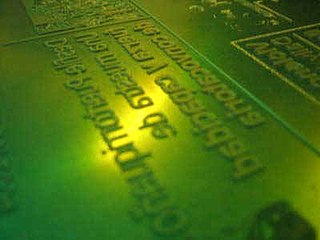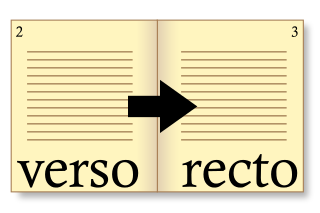
In the field of computing, a printer is considered a peripheral device that serves the purpose of creating a permanent representation of text or graphics, usually on paper. While the majority of outputs produced by printers are readable by humans, there are instances where barcode printers have found a utility beyond this traditional use. Different types of printers are available for use, including inkjet printers, thermal printers, laser printers, and 3D printers.

Laser printing is an electrostatic digital printing process. It produces high-quality text and graphics by repeatedly passing a laser beam back and forth over a negatively charged cylinder called a "drum" to define a differentially charged image. The drum then selectively collects electrically charged powdered ink (toner), and transfers the image to paper, which is then heated to permanently fuse the text, imagery, or both, to the paper. As with digital photocopiers, laser printers employ a xerographic printing process. Laser printing differs from traditional xerography as implemented in analog photocopiers in that in the latter, the image is formed by reflecting light off an existing document onto the exposed drum.

Flexography is a form of printing process which utilizes a flexible relief plate. It is essentially a modern version of letterpress, evolved with high speed rotary functionality, which can be used for printing on almost any type of substrate, including plastic, metallic films, cellophane, and paper. It is widely used for printing on the non-porous substrates required for various types of food packaging.

An MFP, multi-functional, all-in-one (AIO), or multi-function device (MFD), is an office machine which incorporates the functionality of multiple devices in one, so as to have a smaller footprint in a home or small business setting, or to provide centralized document management/distribution/production in a large-office setting. A typical MFP may act as a combination of some or all of the following devices: email, fax, photocopier, printer, scanner.
Optical mark recognition (OMR) collects data from people by identifying markings on a paper. OMR enables the hourly processing of hundreds or even thousands of documents. For instance, students may remember completing quizzes or surveys that required them to use a pencil to fill in bubbles on paper. A teacher or teacher's aide would fill out the form, then feed the cards into a system that grades or collects data from them.

Offset printing is a common printing technique in which the inked image is transferred from a plate to a rubber blanket and then to the printing surface. When used in combination with the lithographic process, which is based on the repulsion of oil and water, the offset technique employs a flat (planographic) image carrier. Ink rollers transfer ink to the image areas of the image carrier, while a water roller applies a water-based film to the non-image areas.

Recto is the "right" or "front" side and verso is the "left" or "back" side when text is written or printed on a leaf of paper in a bound item such as a codex, book, broadsheet, or pamphlet.

Security printing is the field of the printing industry that deals with the printing of items such as banknotes, cheques, passports, tamper-evident labels, security tapes, product authentication, stock certificates, postage stamps and identity cards. The main goal of security printing is to prevent forgery, tampering, or counterfeiting. More recently many of the techniques used to protect these high-value documents have become more available to commercial printers, whether they are using the more traditional offset and flexographic presses or the newer digital platforms. Businesses are protecting their lesser-value documents such as transcripts, coupons and prescription pads by incorporating some of the features listed below to ensure that they cannot be forged or that alteration of the data cannot occur undetected.

LaserJet as a brand name identifies the line of laser printers marketed by the American computer company Hewlett-Packard (HP). The HP LaserJet was the world's first commercially successful laser printer. Canon supplies both mechanisms and cartridges for most HP laser printers; some larger A3 models use Samsung print engines.
Imposition is one of the fundamental steps in the prepress printing process. It consists of the arrangement of the printed product's pages on the printer's sheet, in order to obtain faster printing, simplify binding and reduce paper waste.

IEEE 1284, also known as the Centronics port, is a standard that defines bi-directional parallel communications between computers and other devices. It was originally developed in the 1970s by Centronics before its IEEE standardization.
Variable Data Intelligent Postscript Printware is an open language from Xerox that enables highest-performance output of variable-data PostScript documents. It is used by the FreeFlow VI Suite (VIPP) front end.

A brochure is a promotional document primarily used to introduce a company, organization, products, or services and inform prospective customers or members of the public of the benefits. Although, initially, a paper document that can be folded into a template, pamphlet, or leaflet, a brochure can also be a set of related unfolded papers put into a pocket folder or packet or can be in digital format.

In multifunction or all-in-one printers, fax machines, photocopiers and scanners, an automatic document feeder or ADF is a feature which takes several pages and feeds the paper one page at a time into a scanner or copier, allowing the user to scan, and thereby copy, print, or fax, multiple-page documents without having to manually replace each page.
Canon Production Printing, known as Océ until the end of 2019, is a Netherlands-based subset of Canon that develops, manufactures and sells printing and copying hardware and related software. The product line includes office printing and copying machinery, production printers, and wide-format printers for both technical documentation and color display graphics.

Continuous stationery (UK) or continuous form paper (US) is paper which is designed for use with dot-matrix and line printers with appropriate paper-feed mechanisms. Other names include fan-fold paper, sprocket-feed paper, burst paper, lineflow, tractor-feed paper, and pin-feed paper. It can be single-ply or multi-ply, often described as multipart stationery or forms. Continuous stationery is often used when the final print medium is less critical in terms of the appearance at the edges, and when continuously connected individual sheets are not inconvenient for the application. Individual sheets can be separated at the perforation, and sheets also have edges with punched holes, which also can be removed at the perforation.

Duplex scanning is a feature of some computer scanners, and multifunction printers (MFPs) that support duplex printing. A duplex scanner can automatically scan a sheet of paper on both sides. Scanners without this capability can only scan both sides of a sheet of paper by reinserting it manually the other way up.

Bookbinding is the process of building a book, usually in codex format, from an ordered stack of paper sheets with one's hands and tools, or in modern publishing, by a series of automated processes. Firstly, one binds the sheets of papers along an edge with a thick needle and strong thread. One can also use loose-leaf rings, binding posts, twin-loop spine coils, plastic spiral coils, and plastic spine combs, but they last for a shorter time. Next, one encloses the bound stack of paper in a cover. Finally, one places an attractive cover onto the boards, and features the publisher's information and artistic decorations.
A contract proof usually serves as an agreement between customer and printer and as a color reference guide for adjusting the press before the final press run. Most contract proofs are a prepress proof.
The Xerox 9700 was a high-end laser printer manufactured by Xerox Corporation beginning in 1977. Based on the Xerox 9200 copier, the 9700 printed at 300 dots-per-inch on cut-sheet paper at up to two pages per second (pps), one- or two-sided, that is simplex or duplex, landscape or portrait.












